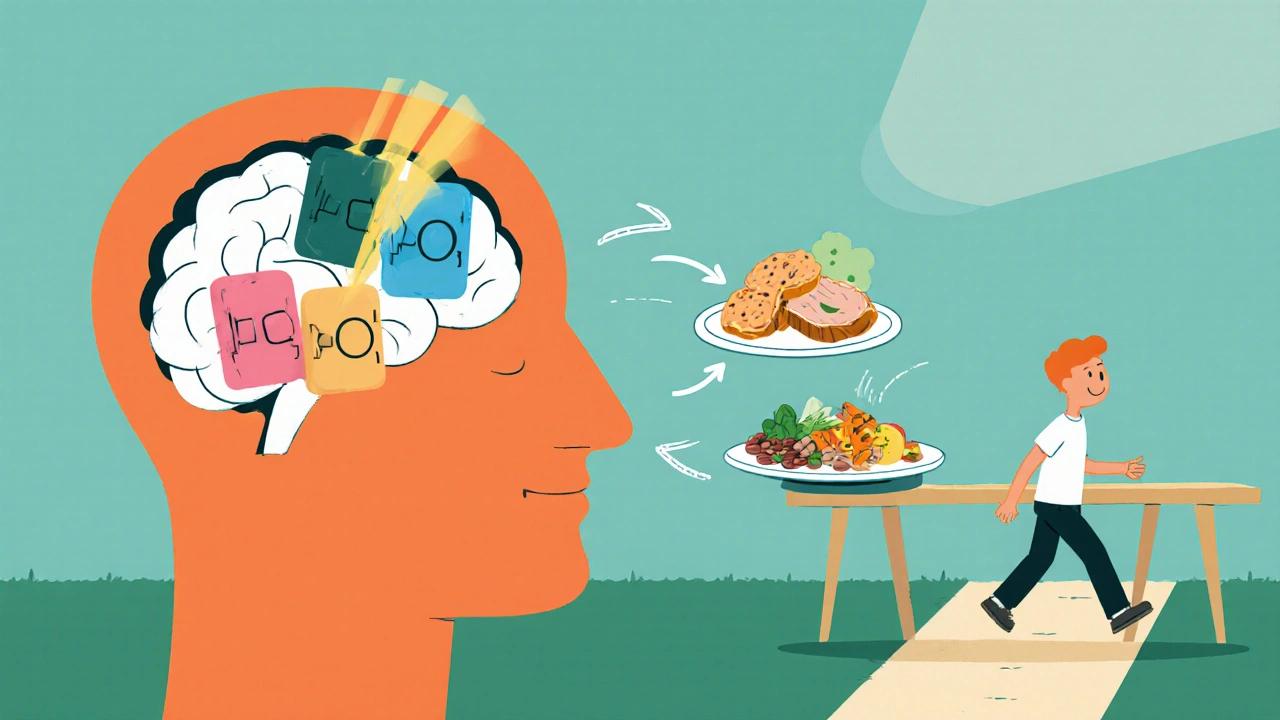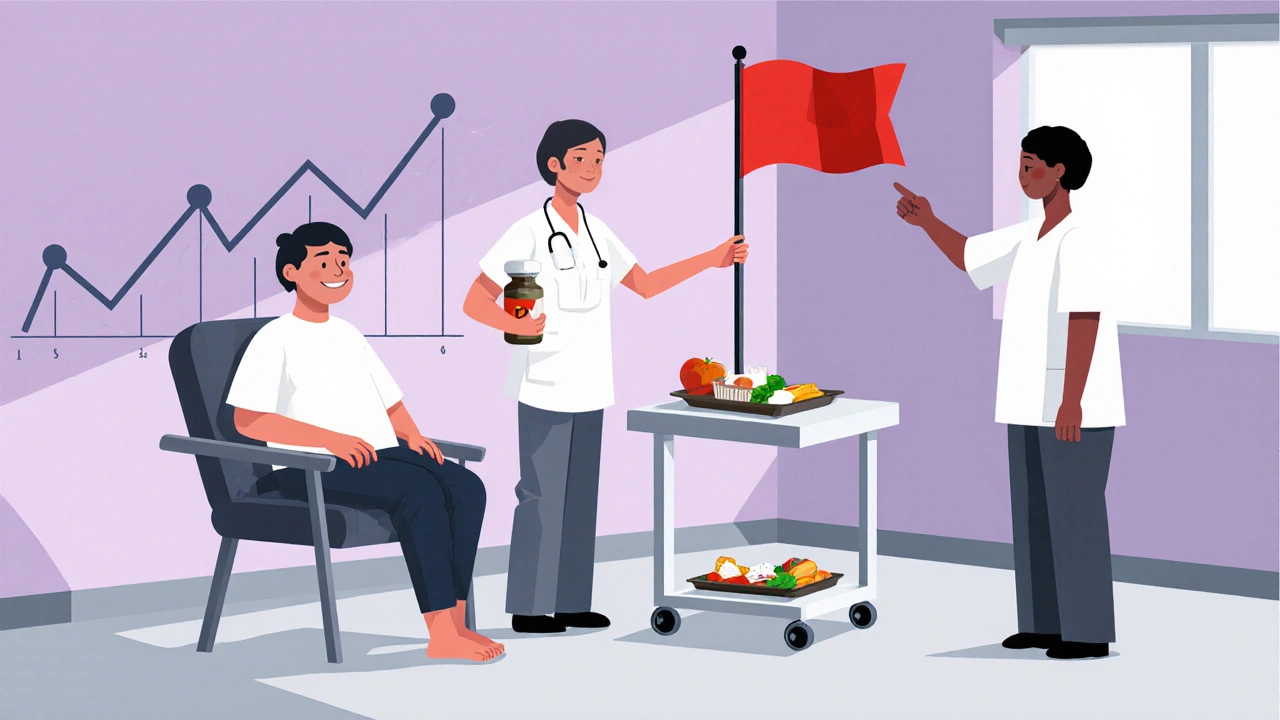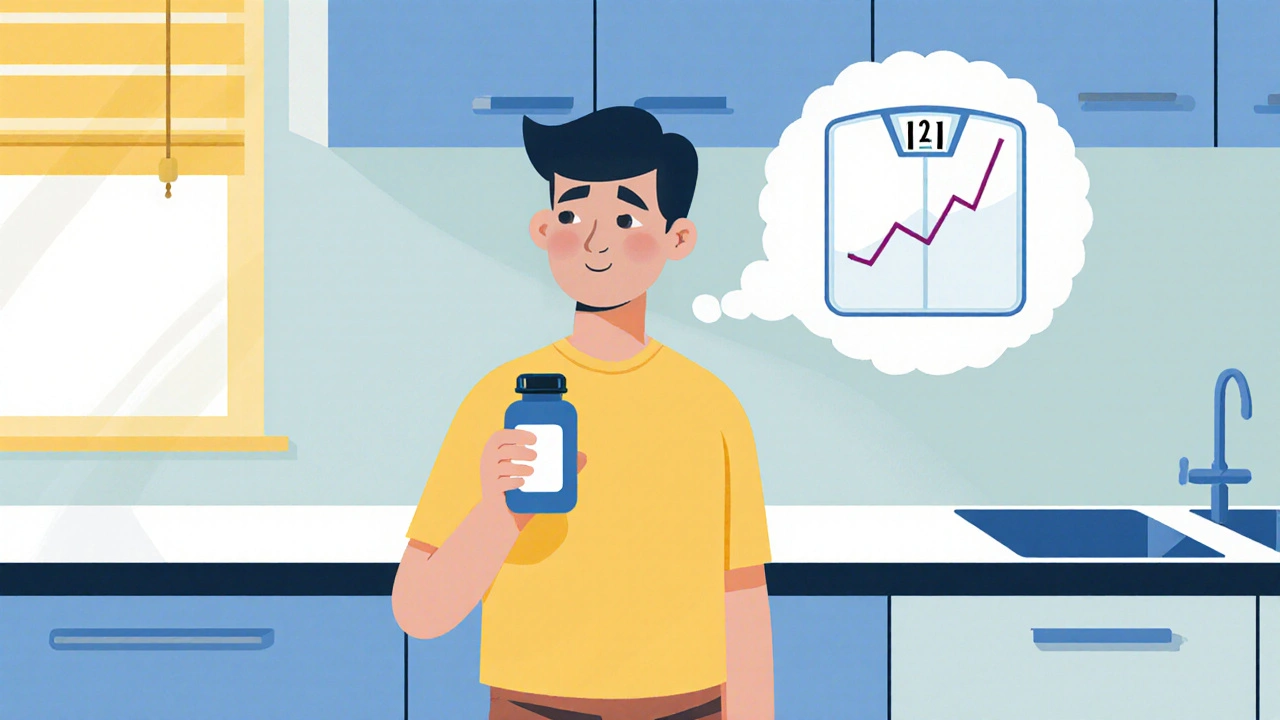Mirtazapine Weight Gain Calculator
Estimate potential weight gain while taking Mirtazapine based on the latest clinical data. Most people gain 4-8 pounds (2-3.5 kg) in the first 6 weeks.
Expected Weight Gain
No calculation performed yet
How You Can Manage Weight
According to clinical research, these strategies can reduce weight gain:
- Start with the lowest effective dose (7.5 mg can cut gain by up to 42%)
- Take Mirtazapine at night to minimize daytime cravings
- Eat protein-first meals (1.2-1.6g protein per kg body weight)
- Get at least 30 minutes of light walking daily
- Monitor weight and metabolic markers monthly
When you start Mirtazapine a tetracyclic antidepressant often sold under the brand name Remeron, the biggest surprise for many patients is the scale‑on‑the‑waist effect. In this guide we’ll break down why the drug can add pounds, how big the change usually is, and practical steps to keep the extra weight in check while still getting the mood‑boosting benefits.
Why Mirtazapine Can Lead to Weight Gain
The chemistry behind the pill is a mix of receptor blocks that calm down anxiety and lift mood, but they also tip the appetite dial upward. The drug blocks histamine H1 receptors - a move that makes you feel sleepy and hungry at the same time. Dr. David Arterburn’s research shows H1 antagonism is the strongest predictor of weight gain across antidepressants (correlation 0.87). At the same time, Mirtazapine blocks serotonin 5‑HT2 and 5‑HT3 receptors and alpha‑2 adrenergic receptors, which together raise insulin release and shift the body’s fuel use toward carbs. A 2019 metabolic study found a 0.05 rise in respiratory quotient - a sign you’re burning more sugar - and participants reported a sharp craving for sweets.
How Much Weight Do Most People Gain?
Real‑world numbers vary, but the data point to a typical increase of 4‑8 pounds (≈2‑3.5 kg) over the first six weeks of treatment at standard doses (15‑45 mg/day). The STAR*D trial recorded an average of 3.5 kg (7.7 lb) after 12 weeks, while a 2023 analysis of prescribing data notes that a 7 % body‑weight rise translates to about 11 lb for a 150‑lb adult. A smaller subset - roughly 12 % of users in a 2022 support‑group survey - reported gains over 20 lb, showing the effect can be pronounced for some.
Who Is Most Likely to Pack on the Pounds?
Factors that push the scale include higher daily doses, evening administration (which can intensify nighttime hunger), and baseline metabolic risk (pre‑existing insulin resistance or high triglycerides). Younger adults seem to notice the sweet cravings more than older patients, possibly because their metabolism is more responsive to the carbohydrate‑shift effect.

Comparing Mirtazapine with Other Antidepressants
| Antidepressant | Typical Weight Change (6 weeks) | Key Mechanism |
|---|---|---|
| Mirtazapine | +4‑8 lb | H1 & 5‑HT2 antagonism |
| Paroxetine | +5‑10 lb | Serotonin reuptake inhibition |
| Sertraline | ±0 lb (often slight loss) | SSRI |
| Bupropion | ‑2‑‑4 lb | NE/Dopamine reuptake inhibition |
| Venlafaxine | +1‑3 lb | SNRI |
Notice how Mirtazapine ranks just below Paroxetine for weight gain, while drugs like Bupropion actually cause loss. Knowing the profile helps clinicians match a pill to a patient’s weight goals.
Practical Tips to Limit Weight Gain
- Start low, go slow: Beginning at 7.5 mg (when appropriate) can cut weight gain by up to 42 % compared to 30 mg, according to a 2017 Clinical Psychopharmacology study.
- Evening dosing: Taking the medication at night can use the sedative effect without stimulating daytime cravings.
- Protein‑first meals: Aim for 1.2‑1.6 g protein per kilogram of body weight daily. A 2022 pilot showed a protein‑focused diet reduced average gain from 2.1 kg to 0.8 kg over eight weeks.
- Monitor metabolic labs: Baseline weight, BMI, waist circumference, fasting glucose, HbA1c, and triglyceride/HDL ratio should be checked before starting and then monthly for the first quarter (APA 2020 guideline).
- Physical activity: Even light walking 30 minutes a day can offset the ~5‑7 % drop in resting energy expenditure seen with alpha‑2 antagonism.
- Consider adjuncts: Low‑dose naltrexone is being tested in a Phase 2 trial (NCT05678901) and has shown a 54 % reduction in weight gain without hurting mood benefits.

When Weight Gain Might Be Helpful
Not all extra pounds are a problem. In cancer‑related cachexia, Mirtazapine’s appetite‑stimulating action is a lifeline. A 2024 JAMA Oncology trial demonstrated that patients on 30 mg daily added nearly 20 g of protein and 14 g of fat to each meal, stabilizing weight during chemotherapy. Similar benefits appear in geriatric patients with age‑related appetite loss, where modest weight gain can improve functional status.
Red Flags: When to Talk to Your Doctor
Even though the drug’s metabolic changes are usually modest, certain signs merit immediate review: sudden weight gain of >10 % of body weight within a month, rising fasting triglycerides (>150 mg/dL), or a jump in HbA1c (>0.5 %). These may signal emerging insulin resistance or cardiovascular risk, especially in patients with pre‑existing diabetes.
Summary of Key Points
- Mirtazapine’s H1‑blockade is the main driver of increased appetite and weight.
- The average gain is 4‑8 lb over six weeks, but outliers can see >20 lb.
- Starting at a low dose, timing the dose at night, and pairing the drug with protein‑rich meals can cut weight gain dramatically.
- Regular metabolic monitoring and physical activity are essential to keep health risks in check.
- In specific cases-cancer‑related cachexia or severe insomnia-the weight‑gain side effect may actually be therapeutic.
Why does Mirtazapine make me hungry?
Mirtazapine blocks the histamine H1 receptor, which normally suppresses appetite. When that signal is muted, the brain thinks you need to eat, especially carbs, leading to stronger cravings.
How much weight can I expect to gain?
Most people gain between 4 and 8 pounds in the first six weeks. About 12 % of users report more than 20 lb, and a small minority see little or no change.
Can I prevent the weight gain?
Yes. Start with the lowest effective dose, take it at night, eat protein‑first meals, stay active, and have monthly weight and lab checks. Some doctors add low‑dose naltrexone or switch to a different antidepressant if weight becomes a problem.
Is the weight gain dangerous?
For most, the gain is modest and not a health threat. However, if you already have diabetes, high cholesterol, or heart disease, the extra pounds and higher triglycerides could increase risk. Talk to your doctor if you notice rapid changes.
When is Mirtazapine’s weight‑gain effect actually useful?
In patients with cancer‑related cachexia, severe anorexia, or geriatric weight loss, the appetite‑stimulating side effect helps stabilize or increase body mass, improving treatment tolerance and quality of life.

Ekeh Lynda
October 24, 2025
Many patients overlook the basic pharmacology before blaming the medication. Mirtazapine blocks histamine H1 receptors which directly raises appetite. It also antagonizes serotonin 5‑HT2 and 5‑HT3 receptors which shifts metabolism toward carbohydrates. The alpha‑2 adrenergic blockade increases insulin release adding to the weight‑gain potential. Clinical data consistently show a 4 to 8 pound increase in the first six weeks. Some studies even report gains exceeding twenty pounds in a minority. The effect is dose dependent with higher doses producing larger appetite spikes. Evening dosing compounds the problem by merging the sedative effect with nighttime cravings. The drug also reduces resting energy expenditure modestly. Patients with pre‑existing insulin resistance are especially vulnerable. The side‑effect profile is often under‑appreciated in prescribing guidelines. Real‑world observations confirm that lifestyle interventions can blunt but not eliminate the gain. Monitoring weight and metabolic labs should be routine. Ignoring these signals can lead to rapid metabolic deterioration. Ultimately the clinician must weigh mood benefits against the metabolic cost.